Does your horse look like this when you put the saddle on?
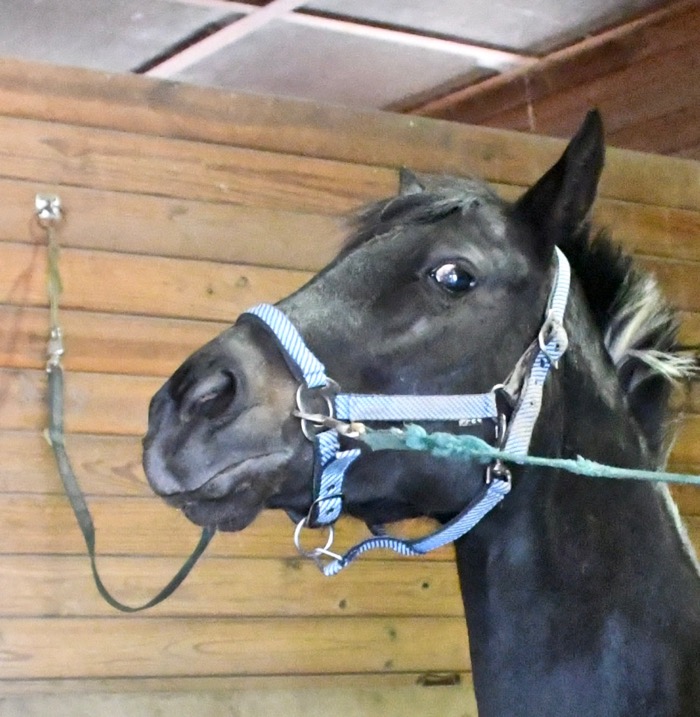
When you try to tighten the girth, does your horse air snap, or reach around and try to bite you?

This behavior is often called being girthy (or cinchy if you use western tack). I don’t like that term, because it refers to the strap that holds the saddle on, and the issue for the horse usually entails far more than that one piece of equipment.
If your horse always presents you with a grumpy face, and gets especially annoyed when being groomed, it could be that there’s an underlying medical issue. Ulcers are the most common instigator of this behavior. Under a veterinarian’s supervision, you can use medication which alleviates the condition. The change in your horse will be quick and seem miraculous.
It could be something else. I know a horse that was considered the classic b*tchy mare. She was put on a course of hormones because the vet and her owner guessed that her estrus cycle was causing pain. They were right, and now she’s the sweetest thing on the ground and so willing under saddle.
If it’s not a medical condition, then being girthy could be due to ill-fitting tack. Tonka, when I purchased him, had excellent manners at the mounting block. Several months into ownership, he got antsy before I got on, moving away from me. I tried retraining him, with no success. It took me a couple of days before it dawned on me that the new, super-comfy, fleece girth that I’d bought for him had stretchy elastics that I was pulling too tight. When I loosened the girth the “bad” behavior went away. I apologized profusely to my horse for how long it took me to figure this out! I’m not an expert in western gear, but I have a few students who ride western, and they’ve all had cinchy horses. I’ve noticed that in order to attach the cinch, they have to pull it upwards and tight, then ease up a bit as they loop the strap. None of the horses like this. If anyone can advise me on how to tighten a cinch without doing that, please leave a comment!
The saddle itself is often a cause of pain. I’ve written about the saga of finding a saddle for Tonka here.
Sometimes it’s not the fit of the saddle, but how you put it on that matters. Slapping a heavy saddle onto a horse’s back is never a nice thing to do. When I was in Iceland, I noticed how gently the saddle was set down on my mount’s back. It helped that the owner was tall, the horse short, and the saddle was light. If it’s awkward for you to get the saddle on, consider using a step stool.
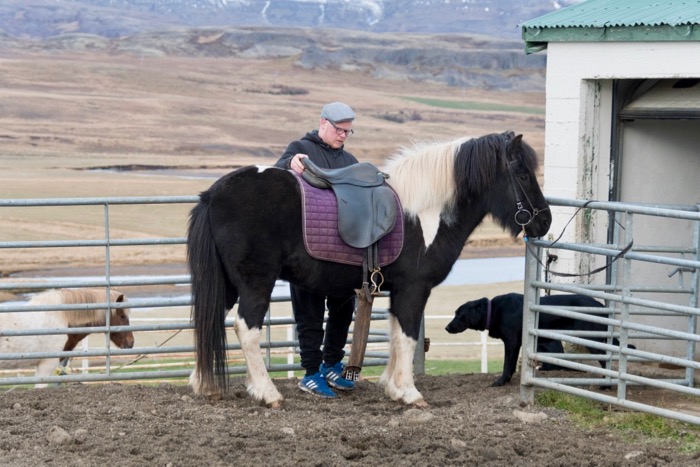
It’s okay if a horse glances back at you when tacking up.
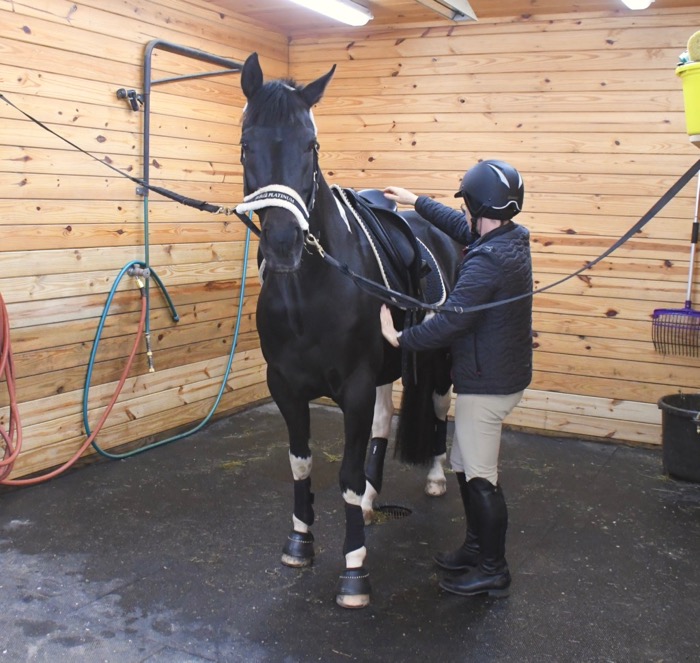
But they shouldn’t move around trying to evade the tack, and once saddled, they should look relaxed about what comes next. (Notice Tonka’s hanging lower lip. A sure sign that he thinks all is right with his world.)
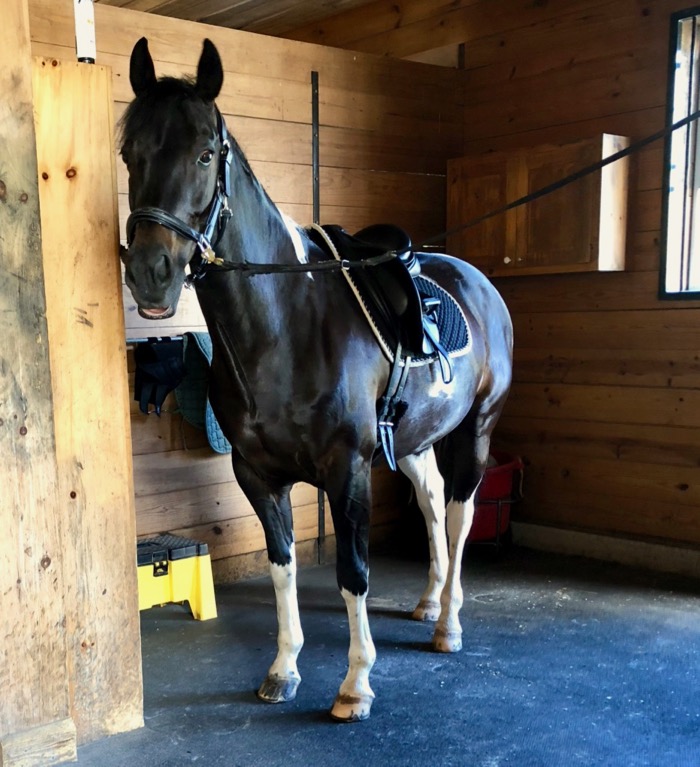
Once medical conditions and poorly fitting tack are ruled out, you still might have issues. Horses that have experienced pain will be wary that it will happen again. You’ll have to convince your horse that things have changed for the better. To do this, I rely on counter-conditioning. (I’ve written about that here.)
Each horse has a different thing that triggers their cinchyness.
I worked with a horse who pinned his ears when the saddle was put on, but I knew that wasn’t the whole story. I noticed that his angry expression would start when he heard the sound of the double bridle jingling in the tack room. It turned out that he’d been pushed too hard as a dressage horse, and the double bridle was the trigger for all of the memories of pain and harsh demands. He now goes in a bitless bridle, and the tacking up is easy.
Recently, Tonka got girthy when his sacroiliac joint pain flared up. He was letting me know that he knew that if I got on, it’d hurt. Yes, a horse is capable of making that intelligent connection! For a couple of weeks, while waiting for his medical appointment, I didn’t ride him. During that time, I wanted to disconnect Tonka’s association of the saddle with pain. So, I tacked him up, with a loose girth, and took him out to hand-graze. In this way, saddling became linked with good things.

If you have a cinchy horse, first eliminate disease, pain and ill fitting tack. If he’s still cinchy, ask him some questions.
Are you okay with the saddle pad being put on?
What about when you see the saddle?
How about when it’s on your back?
Does the girth hanging down worry you?
When it’s brought around your belly?
When I buckle it up?
If your horse answers any of these questions with signs of discomfort, then that’s the place to start counter-conditioning. I did this with Tonka. My horse relaxes when he chews, and he especially likes to crunch carrot chunks, so I used that knowledge to my advantage. Tonka’s trigger began with the saddle pad (he’d give me a look and narrow his nostrils) so he got a carrot when I walked up to him with the pad, and another when I put it on his back. Then, a carrot when I stood near him with the saddle. Another carrot when I set the saddle on his back, another when I reached around his belly for the girth, and another as I buckled it. If he had gotten tense at any point I would have backed up to the previous step, and worked my way back through the saddling procedure. But I didn’t have to. In fact, in each subsequent tacking up session, I was able to lump the steps together, until the whole process was done for just one reward when the girth was tightened up.
Tonka is back to letting me tack him up without worry (old photos for illustration purposes.)
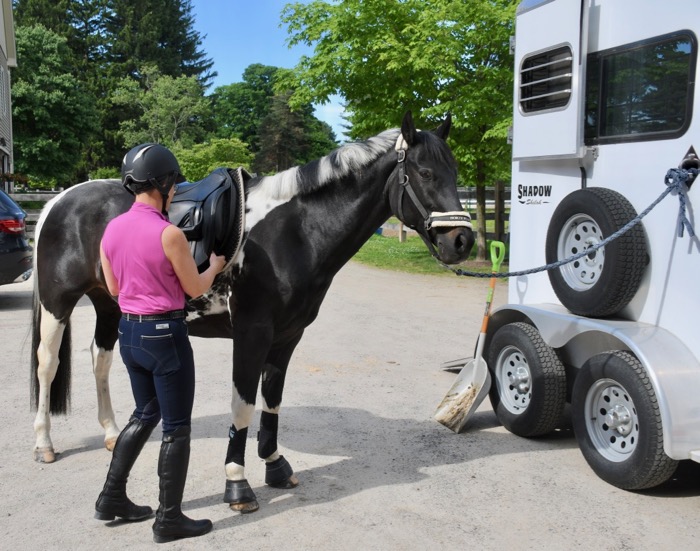
Once again, he has perfect mounting behavior.

Have you had a cinchy horse? Do you currently have issues when tacking up? Tell me about it in the comments.


My horse Cody has always been quite cinchy. Nothing happened during saddling. It is always when I untie him and move his feet. After ruling out pain, saddle fit and working with him forever, I started to realize it didn’t seem to be pain at all. In fact he never moved a muscle while being tacked up, either when the saddle was put on, or when the cinch tightened I noticed he would actually hold his breath (because I can barely get the cinch around him!), and when I untie him and walk him, it’s as if he is waking up from a dream and suddenly has this big scary saddle on his back. It usually just takes a couple steps for him to breath, relax and realize it’s not going to eat him. And there is no rhyme or reason to when it happens. It can happen once, then not again for weeks. One other thing we have noticed is that here in California when it is cold and dry in the winter, we get a lot of static. He always seems cinchier during winter months We figured out that there was probably static in his wooly winter coat under the saddle pad. We started dampening his coat with water to take out the static before saddling, and that has helped to alleviate a lot of it in the wintertime.
Laura, I’m so glad that you sent this comment. Static! It’s a real problem. I know someone who had a terrible fall because the quarter sheet on her horse zapped him and he bolted. I’ve used anti-static sprays on my horse’s blankets, but I couldn’t bear the strong scents. I found a spray at an Equine Affaire vendor and it works great and barely has an odor. I use it on his brushes (gets rid of winter dander and the static) and whenever I put a pad or blanket on or off. The ingredients are water, glycerin and aloe. When I run out, I’m going to try to mix my own. I’ll post a recipe if I have any success.
I’ll be very interested to see your recipe! That’s definitely a problem here at this time of year.
I am realizing I’m cinching too tight. I thought the saddle shouldn’t move at all when I mounted. Now I have investigated and think I am mounting wrong and it’s ok if it slides some. She was also acting not herself under saddle.
If you have a round horse, like a quarter horse, draft, hafflinger, etc, then it’s impossible to cinch so tight that the saddle doesn’t move 🙂 Girth so that the saddle is secure and doesn’t slip with normal pulling. Always get on from a mounting block. It keeps the saddle from pulling to the side, and it’s kinder to the horse.
I’ve always used a mounting block too, mostly because I had a tall horse, and I’m short! I’ve just gotten a new horse, and she’s only 13.3 hands, but I will still continue to always use a mounting block. I spend way too much money keeping my horse’s back feeling good (chiropractic, accuscope, etc.) to pull on them when I’m getting on.
Lance was clearly Not.Happy. about saddling when I first got him. I worked hard to find a saddle that fit him, cushioned with first a sheepskin half-pad and now a CorrecTor pad, and changed to a Shoulder Relief girth. Finally, he always gets some hay to eat while I groom him and tack him up. He no longer fidgets nor flattens his ears (although he’d rather not have his upper neck brushed); I’ve removed all the areas of discomfort. Oh, and I nearly ALWAYS mount from something (fence, stump, rock) so I don’t torque the saddle tree on his back by putting weight in one stirrup to KEEP him comfortable.
The hay before riding is such a good idea. I’m finally hearing veterinarians recommend this. So pleased they’re looking at the whole picture.
I ride western and tie my cinch, first I just put it kind of loose just to keep the saddle in place, then do something else, then tighten it up some again,run my hand under the cinch to make sure it’s not pinching, I may do this 4 times or so before mounting. Sometimes I stretch the horses front leg out some. The last time is just before mounting, I walk the horse a little,then mount (from a block or whatever). I’ve seen some bad cinchy horses, from flying backwards, to just plain laying down.
Much easier to prevent it than to try and cure that behavior.
I have the static problem when brushing also.
Thanks for your cinching advice!
I should have added I went through several saddles, kind of like you did, before I found one that worked for both the horse and myself.
Thank you for your suggestions. My mare became inexplicably girthy. We discounted ulcers, had her checked by a vet, and had a series of equine massages for her (she had recently been hauled across Canada for the second time. Travel, being a common cause of ulcers and general body aches and pains, that was our first thought.) At our last barn, I had my coach riding her. Once in a while one of my coach’s apprentices was riding her. I assume that not everyone has the same consideration for doing up her girth one hole at a time. Now that I am the only one riding her, perhaps she anticipates being “yanked up by her bra straps”, even though I have never done this! I will try the carrots as you suggest!
“Yanked up by the bra straps” Thank you for that phrase!
Make sure that the carrots happen when she is relaxed, or at least looking eager, not tense. Otherwise you could inadvertently reward ear pinning. Take twice as much time at first as you think you need, and you’ll progress twice as fast 🙂
Do you have a discussion as well of horses that aren’t girth or cinch, but resist being mounted once ulcers are ruled out?
Not one comprehensive post… I have talked about how Tonka avoided my getting on when the saddle didn’t fit. Also, if they have back issues, make sure that the horse is standing square before getting on – it makes it more comfortable for them. I’ve written about that, too. But a horse that doesn’t like being mounted could be telling you one of so many things! I’ve had students who, once they get on fuss and shift before sitting down. That annoys the horse so much that the horse anticipates it and gets antsy before mounting.
I have a 22 yr old QH ho has been girthy quite some time. I have owned him since he was 5 months old. I honestly can’t remember when he got girthy but it has been a long time. He lives out 24/7 with 7 other horses either hay or pasture 24/7 & the sweetest personality except saddling. In cross ties he bites at the air. Once saddled he is a joy to ride & no issues under saddle. He gets vit/min supplement & is pleasure ridden 3 times a week. He has regular massages & chiro. I have spoken to my vet & he really did not suggest scoping as horse lives in a very stress free environment. Has been my vet over 25 years. Horse is a very stocky horse & girth needs to be quite snug or saddle slips. Saddle fitter says saddle fine. Any suggestions?
My guess (and it is a guess) is that he is anticipating the unpleasantness of having that girth pulled up tight. My own horse hates that and became girthy very quickly after a saddle fitter yanked a girth on. I bought a girth a size too big so that I could buckle it without pulling at all. Then, as I tightened it up -slowly- I gave my horse a treat for each hole. After much gradual work and lots of carrots, I can now use a normal-sized girth and I give just one cookie when my horse is standing with his head forward, relaxed. You don’t say if you use western or English tack. If English, get a girth that has elastic on both sides and don’t over-tighten. If Western, can you change the style of the girth? The type with the strap requires you to pull up and past the tightness before you wrap it around. Your horse might be objecting to that.
I have a new mare Ottb I got as a lesson horse. At the previous owners place she was groomed and tacked in a groom stall and tied. She stood perfectly still and quiet the entire time. At my place we don’t have groom stalls and horses are tacked in an open aisle with crossties. This makes her nervous so we have been working on it. In the aisle she’ll let me tack her just fine but gets antsy after a while but never girthy. I tried tacking her in the stall and she doesn’t bite but pins her ears back and acts like she’s about to bite when I do the girth (which I do very slowly) or check the girth to make sure it’s tight enough. Never tries this in the aisle but again gets antsy and pushes into the walls in the aisle.
Who knows what has caused her anxiety? Maybe it’s not the girth, but slapping a saddle on. Or a static shock. Or? But trust that the anxiety has a root. Sometimes if you change one small thing it reduces the anxiety. She might do better if restrained with only one x-tie. Or try tacking up from the other side. Or, she might not be anxious about the tacking, but about other horses passing her in the aisle. Even if you never uncover the root of it, starting from a place of empathy, as you are doing, will help tremendously.
Thank you! She’s definitely nervous about the aisle. Usually calm in her stall. We keep it calm with no horses walking by. I was shocked she was girthy in the stall. Should I keep working with her in the aisle? Grooming only and treats? I just didn’t want treats to become a crutch. Thanks for your help
Some horses are anxious from pain. Perhaps she has ulcers? Very common with OTTBs. Treats are good IF they are given in a way that promotes relaxation. It’s not easy to do! Better for an anxious horse is to put a tub of hay in front of her while you work with her. Munching is calming. Also, when grooming, ask her which brushes she likes. Sometimes just listening to her preferences changes everything. (For some reason Tonka hates the softest brush I have. When I stopped using it he was relieved. You never know!)
Thank you for the suggestions! I know tb are prone to ulcers but since she previously wasn’t girthy I assumed she was fine. I didn’t think of ulcers causing anxiety. Would it hurt for me to go ahead and treat her for that with an ulcer guard? And I’ll be using all of your advice. Thanks again
That’s a question for your veterinarian 🙂
Think about this about pain: it is distracting. Horses can’t afford to be distracted. They need to be aware of their surroundings. So pain can make them spooky and worried.
I have a new mare Ottb I got as a lesson horse. At the previous owners place she was groomed and tacked in a groom stall and tied. She stood perfectly still and quiet the entire time. At my place we don’t have groom stalls and horses are tacked in an open aisle with crossties. This makes her nervous so we have been working on it. In the aisle she’ll let me tack her just fine but gets antsy after a while but never girthy. I tried tacking her in the stall and she doesn’t bite but pins her ears back and acts like she’s about to bite when I do the girth (which I do very slowly) or check the girth to make sure it’s tight enough.